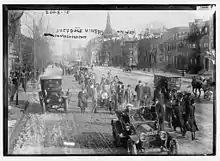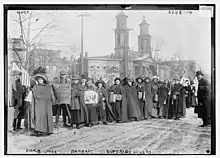Suffrage Hikes
Die Suffrage Hikes (deutsch: Wahlrechtsmärsche) zwischen 1912 und 1914 sollten die US-amerikanische Öffentlichkeit auf die Forderung nach dem vollen Frauenwahlrecht in allen Bundesstaaten der USA aufmerksam machen.[1] Rosalie Gardiner Jones organisierte den ersten 13-tägigen Marsch von Manhattan nach Albany.[2][3] Organisatorinnen und Beteiligte, die die gesamte Strecke marschierten, waren fünf Frauen:[4] Emma Bugbee,[5] Ida Craft,[6] Elisabeth Freeman,[7] Rosalie Gardiner Jones[7] und Lavinia Lloyd Dock.[4]



Marsch nach Albany 1912
Dieser Marsch begann am 16. Dezember 1912 und führte von einer U-Bahn-Station in Manhattan nordwärts. Von den 500 Frauen, die an der Startveranstaltung teilnahmen, kamen 200 mit auf den Marsch. Nach knapp 14 Tagen kamen die ersten vier Pilgerinnen am 28. Dezember in Albany an.[3][8]
Marsch nach Washington 1913
Dieser Marsch begann im Hudson Terminal in New York City am 12. Februar 1913[9] und führte über Newark, Metuchen[9] nach Philadelphia und Baltimore[7][6] und endete in Washington, D.C. auf der National Mall.
Einzelnachweise
- Marching for the Vote, Library of Congress (englisch)
- Gen. Jones's Hike Starts. Her Suffragist Army Will Carry a Petition to Albany., New York Times, 2. Januar 1914 (englisch)
- Ida Husted Harper, Susan Brownell Anthony, Matilda Joslyn Gage: History of woman suffrage, 1922 (englisch)
- Barbara Sicherman und Carol Hurd Green (Hrsg.): Notable American Women: The Modern Period: a Biographical Dictionary. Belknap Press of Harvard University Press, Cambridge/Mass. 1980, ISBN 0-674-62732-6, 197.
- Two Case Histories, Ishbel Ross and Emma Bugbee: Women Journalists Ride the Rail with the Suffragettes., Education Resources Information Center Zitat: „Bugbee walked with the suffragists on a week-long winter march from New York City to Albany“
- Col. Craft Is Angry. Snub For Gen. Jones. Talks of Rushing About Country at Six-Day-Bicycle-Race Speed and Says She Doesn't Like It.. In: New York Times, 25. Februar 1913. Abgerufen am 14. August 2009. „So angry that she would not speak to General Rosalie Jones Colonel Ida Craft, second in command, led the detachment of suffragist hikers that spent the night at Overlea into Baltimore late this afternoon. General Jones was not in the lobby of the Hotel Stafford when Colonel Craft came tramping in.“
- Col. Craft Walks On, But Hikers Protest. Her Feet Swollen So Badly That She Falls Behind Companions. Says 'I Am Going Through., New York Times, 23 Februar 1913
- New York Times, 17 Dezember 1912 Zitat: „Six Tired Pilgrims End First Day's Hike. But the Drum Gives Out at the Start of the Suffrage March on Albany.“
- Suffrage Hikers Undaunted By Cold. Plod on to Metuchen, N.J., Though One Woman Needs a Doctor When She Gets There. (PDF). In: New York Times, 13. Februar 1913. Abgerufen am 30. Juli 2009. „'The Army of the Hudson,' the warlike name selected for the suffragette hikers by Gen. Rosalie Jones, arrived in this town to-night after its first day's march toward Washington, where it will take part in the suffragette parade on March 3.“